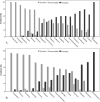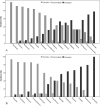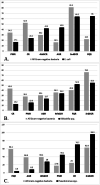Bloodstream infections in adult patients with malignancy, epidemiology, microbiology, and risk factors associated with mortality and multi-drug resistance
- PMID: 34215207
- PMCID: PMC8254331
- DOI: 10.1186/s12879-021-06243-z
Bloodstream infections in adult patients with malignancy, epidemiology, microbiology, and risk factors associated with mortality and multi-drug resistance
Abstract
Background: This study aimed to investigate the epidemiology, microbiology, and risk factors associated with mortality and multi-drug resistance bacterial bloodstream infections (BSIs) among adult cancer patients in Shiraz, Iran. We also report a four-year trend of antimicrobial resistance patterns of BSIs.
Methods: We conducted a retrospective study at a referral oncology hospital from July 2015 to August 2019, which included all adults with confirmed BSI.
Results: 2393 blood cultures tested during the four-year study period; 414 positive cultures were included. The mean age of our patients was 47.57 ± 17.46 years old. Central Line-Associated BSI (CLABSI) was more common in solid tumors than patients with hematological malignancies. Gram-negative (GN) bacteria were more detected (63.3%, 262) than gram-positive bacteria (36.7%, 152). Escherichia coli was the most common gram-negative organism (123/262, 47%), followed by Pseudomonas spp. (82/262, 31%) and Klebsiella pneumoniae (38/262, 14.5%). Coagulase-negative staphylococci (CoNS) was the most frequently isolated pathogen among gram-positive bacteria (83/152, 54.6%). Acinetobacter spp., Pseudomonas spp., E. coli, and K. pneumoniae were the most common Extended-Spectrum Beta-Lactamase (ESBL) producers (100, 96.2, 66.7%, and 60.7, respectively). Acinetobacter spp., Pseudomonas spp., Enterobacter spp., E. coli, and K. pneumoniae were the most common carbapenem-resistant (CR) isolates (77.8, 70.7, 33.3, 24.4, and 13.2%, respectively). Out of 257 Enterobacterales and non-fermenter gram-negative BSIs, 39.3% (101/257) were carbapenem-resistant. Although the incidence of multi-drug resistance (MDR) gram-negative BSI increased annually during 2015-2018, the mortality rate of gram-negative BSI remains unchanged at about 20% (p-value = 0.55); however, the mortality rate was significantly greater (35.4%) in those with resistant gram-positive BSI (p-value = 0.001). The overall mortality rate was 21.5%. Early (7-day mortality) and late mortality rate (30-day mortality) were 10 and 3.4%, respectively.
Conclusions: The emergence of MDR gram-negative BSI is a significant healthcare problem in oncology centers. The high proportion of the most frequently isolated pathogens were CR and ESBL-producing Enterobacterales and Pseudomonas spp. We have few effective choices against MDRGN BSI, especially in high-risk cancer patients, which necessitate newer treatment options.
Keywords: Bloodstream infection; Cancer; Carbapenem-resistant isolates; Extended-Spectrum Beta-lactamase producing pathogens; Mortality; Multidrug-resistant gram-negative infection.
Conflict of interest statement
The authors do not have any financial or other relationships, which could regard as a conflict of interest.
Figures







References
-
- El-Mahallawy HA, Hassan SS, El-Wakil M, Moneer MM, Shalaby L. Increasing antimicrobial resistance monitored in surveillance analysis of blood stream infections in febrile neutropenic pediatric oncology patients. Asian Pac J Cancer Prev. 2015;16(14):5691–5695. doi: 10.7314/APJCP.2015.16.14.5691. - DOI - PubMed
-
- Kang C-I, Kim S-H, Park WB, Lee K-D, Kim H-B, Kim E-C. Oh M-d, Choe K-W: bloodstream infections caused by antibiotic-resistant gram-negative bacilli: risk factors for mortality and impact of inappropriate initial antimicrobial therapy on outcome. Antimicrob Agents Chemother. 2005;49(2):760–766. doi: 10.1128/AAC.49.2.760-766.2005. - DOI - PMC - PubMed
-
- Easow JM, Joseph NM, Dhungel BA, Chapagain B, Shivananda PG. Blood stream infections among febrile patients attending a teaching hospital in Western region of Nepal. Australasian Medical Journal. 2010;3(10):633–637. doi: 10.4066/AMJ.2010.422. - DOI
Publication types
MeSH terms
LinkOut - more resources
Full Text Sources
Medical
Miscellaneous

